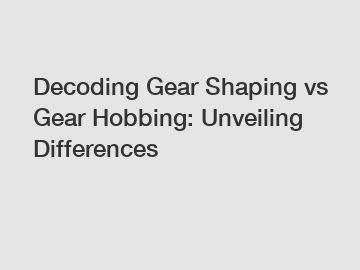Dec. 18, 2023
Machinery
Decoding Gear Shaping vs Gear Hobbing: Unveiling Differences.
Gears play a vital role in the functioning of machines across various industries. They enable the smooth transfer of power and motion between different mechanical components. However, the manufacturing of gears requires specialized processes, with gear shaping and gear hobbing being two popular methods. While they may seem similar at first glance, there are distinct differences between the two techniques. In this article, we will delve into the details of gear shaping and gear hobbing, uncovering their dissimilarities and helping you understand which method might be best suited for your specific gear manufacturing needs.
Gear Shaping: Precision in Motion.

Gear shaping is a machining process that involves the use of a cutting tool called a shaper cutter. This cutter, which has a series of teeth, is mounted on a reciprocating ram. The gear being shaped is placed on a spindle, which rotates as the cutter reciprocates. As the cutter moves across the gear blank, it precisely cuts the teeth into the workpiece.
One of the key advantages of gear shaping is its ability to produce gears with high precision. The process ensures accurate tooth shape and smooth surface finish, which is crucial for achieving optimal performance and durability. Gear shaping is often preferred for delicate or complex gear designs that may not be suitable for other methods.
Gear Hobbing: Efficiency and Versatility.
Gear hobbing, on the other hand, is a process that utilizes a gear hob – a cylindrical cutting tool with helical teeth – to create gears. The hob is mounted on a hobbing machine, and the gear blank is held in a fixture called a hobbing machine arbor. As the hob rotates, it cuts into the gear blank and forms the desired teeth.
One of the significant advantages of gear hobbing is its efficiency. It allows for the simultaneous cutting of multiple teeth, enabling faster production compared to gear shaping. Gear hobbing is also highly versatile, as it can be used to manufacture a wide range of gears, including helical gears, spur gears, and worm gears. This versatility makes gear hobbing a popular choice for mass production requirements.
Comparing Gear Shaping and Gear Hobbing.
Further reading:While both methods share the common goal of producing gears, there are several factors that set gear shaping and gear hobbing apart. Here are some key points of distinction:
1. Complexity: Gear shaping is ideal for intricate gear designs that require precise tooth profiles, while gear hobbing is suitable for simpler gear profiles and mass production.
2. Speed: Gear hobbing is generally faster than gear shaping due to its ability to cut multiple teeth simultaneously.
3. Surface Finish: Gear shaping produces gears with a smooth surface finish, while gear hobbing may leave slight imperfections on the gear teeth.
4. Versatility: Gear hobbing is more versatile, capable of producing a wider range of gear types.
Choosing the Right Method for Your Needs.
When it comes to selecting between gear shaping and gear hobbing, several factors need to be considered. The complexity of the gear design, desired production speed, surface finish requirements, and volume of production are all crucial considerations. Consulting with an expert in gear manufacturing can help determine the most suitable method for your specific needs.
If you have any further questions or require assistance in gear manufacturing, please do not hesitate to contact us. Our team of experts is ready to provide tailored solutions to meet your specific requirements.
Contact us today to learn more about gear shaping, gear hobbing, and our extensive range of gear manufacturing services.
Contact us to discuss your requirements of cnc hobbing machine, china gear shaving machine supplier, Horizontal Hobbing Machine. Our experienced sales team can help you identify the options that best suit your needs.
Further reading:Related Articles
If you are interested in sending in a Guest Blogger Submission,welcome to write for us!
All Comments ( 0 )